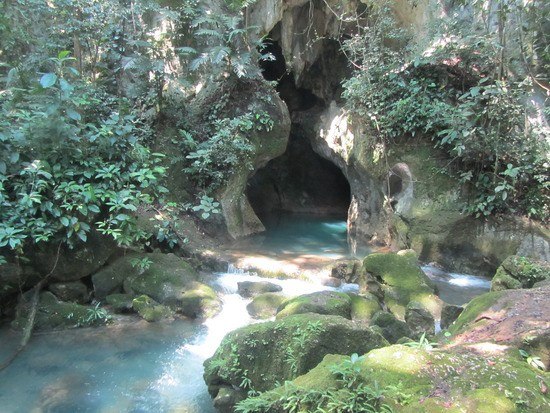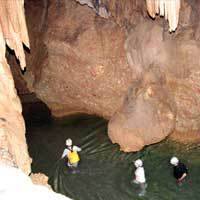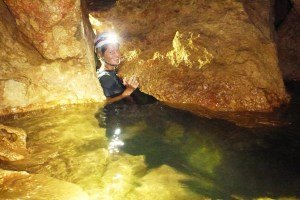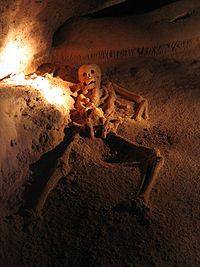Belize’s Actun Tunichil Muknal has been named the #1 Sacred Cave in the World by National Geographic. That distinction alone is enough to attract serious archaeology fans and spelunkers from all over the world. Add the fact that accessing the cave requires a one hour hike through the jungle, while crossing the meandering Roaring River three times- just to get to the mouth of the cave- and you have an adventure that narrows it down to those who are fit enough for this Indiana Jones experience.
My first visit to Mayan ruins was Belize’s Altun Ha in 1990. Between 2005 and 2015, I visited Lamanai and Xunantunich in Belize, and Chichen-Itza in Mexico.
I didn’t learn about Actun Tunichil Muknal- the cave of the “Crystal Maiden”- until 2010. I was intrigued that even though this site offers a unique opportunity to view skeletal remains in the place where the victims were sacrificed, there’s very little information available- especially about what a visit to this cave entails.
I began to ask around. In 2010, Actun Tunichil Muknal wasn’t on the list of standard Belizean tours, and the Belize Institute of Archaeology’s website still has no information about Actun Tunichil Muknal in 2016- even though it’s one of their own archaeological sites. Not sure why.
The only detail that I knew for sure was that Actun Tunichil Muknal is not for wimps. It’s a veritable obstacle course of jungle, river, caving and climbing.
I had to seek out word of mouth accounts in an attempt to judge my own ability, and it took me a couple of years to get mentally and physically fit for the adventure.
This year I was confident that I could do it. When I arrived in Belize, I acclimated myself to the heat by spending the ten days prior to the trip with a daily 2-hour fitness combination of either 1-hour hike + 1-hour bike ride or 1-hour hike + 1-hour kayaking.
The morning of the trip, I paced back and forth on the dock watching the sunrise, while waiting for the boat to take me to town where I would board a flight to Belize City on Maya Island Air. I still had doubts. I was really nervous.
On the dock, I met my travel companions, a couple from Fairbanks, Alaska who were in their 50s, and had the same travel, hiking, caving and climbing experience as I. That was a huge plus because we were going to need to become a support team for each other. I began to feel better.
In retrospect, now that it’s over, I’m in awe. If you asked me to go back tomorrow, this is one trip that I’d repeat without hesitation for the sheer opportunity to absorb the experience again and to try to retain as much as possible.
One is limited to carrying in only the clothes on one’s back, so there’s no photography, no audio recording, and no note taking. Bring a change of dry clothes. They’ll be locked in your guide’s vehicle. (I’ve included a few photos from the time prior to the change in regulations, and have included credits.) The reason for the regulations is that visitors to the cave have damaged skulls by dropping items onto them, most notably, a man dropped a heavy SLR camera onto a skull breaking it. Another person’s carelessness broke a tooth on a skull.
It’s difficult to judge the time and distance during the hike and in the cave, but I’m going to do my best to be accurate in all details.
From the boat to the airport in San Pedro, we were accompanied by Guide #1, Vince. Our flight to Belize City was delayed for an hour (?) or more due to fog on the mainland. Visual flight rules.
When we finally arrived in Belize City, we met Guide #2, Freddy, who was going to drive us out to the cave’s access road. We share his enthusiasm for his native Belize. We talked all the way out of the city and on the Western Highway from Belize District and into Cayo. Belize politics, economics, business, agriculture, history, flora & fauna, gossip & misinformation- and more. The time flew by as the terrain changed from tropical to sub-tropical. Meanwhile, Freddy received two or three phone calls from our official cave guide, wanting to know where we were. Freddy was driving the speed limit. He was doing his best.
We passed the Belize Zoo (a very small, very nice, animal preserve) and the Sleeping Giant Mountains. After a little over an hour’s drive, we arrived at a place somewhere beyond the turnoff for Belmopan, the capital city.
We left Freddy at the beginning of an eight-mile dirt road (At least, I’ve been told it’s eight miles.) and we transferred to another vehicle with Driver #3, in order to meet our official Actun Tunichil Muknal guide #4. It was beginning to feel like we were trying to shake a tail in a film noir.
On the dirt road, we passed mahogany plantations, beautifully pruned to reach the sky with straight stock. Our vehicle drove through the Roaring River, about ten inches deep at this place, just like the creeks I was used to crossing back in the US when we lived in northwest Arkansas. The young women, who had joined us at the beginning of the dirt road, squealed.
There are only 24 guides for Actun Tunichil Muknal. It requires study of a two-inch-thick textbook and extensive classes in San Ignacio. A big commitment, followed by testing. Once licensed, the guides can take only groups of eight into the cave, usually one group per day. This is not a Disney-esque concession.
At this point, I have to say that I have good news and bad news. The good news is that Actun Tunichil Muknal Cave was definitely the best adventure I’ve ever come across in a foreign country.
The bad news? Our guide was really nasty and unprofessional. He was annoyed about the flight delays and took it out on us- even though there was no problem with the cave schedule and nothing else was affected by our delay. His frustration caused him to put us in danger as he forged ahead without looking back- both on the trail, and inside the cave.
The writing was on the wall as soon as I got out of the car. The absolute only thing that we’d been told was that we would be swimming in our clothes and shoes, and that we should bring a pair of dry socks to wear once we got to the part of the cave that holds the sacred skeletal remains and artifacts.
I got out of the car and asked:
“What should we do with our socks?”
Well, that was a mistake. I got blasted.
“Never mind thee socks! Go to the bah-throom! Get back here and get your helmet and head lamp!”
Uh. OK. I did as directed. I’m not going to reveal his real name here, even though the danger that he subjected us to surely calls for some kind of disciplinary action. Let’s just call him “Bozo”.
The three of us were joined by five others, a 50ish couple from Vancouver, Canada and three young women from New York. Looking around the parking lot, it was obvious that 95% of the others were under 30 years old. Under 30? Piece a cake. Did I mention that I’m 65? I asked another guide how old his oldest participant has been. He said 90-something.
Me: “Former Triathalete type?”
Guide: “Yes.”
As soon as we eight were assembled with our gear, Bozo led us into the jungle down a well-cleared clay path. Just slippery enough to get your attention.
After a while, we came to a clearing where we were directed to leave our water bottles. Since it was overcast, I removed my sunblock shirt and left it on the side of the trail. I was glad I did. A Speedo tank suit and lightweight river pants turned out to be just right for the swimming and climbing. Don’t wear clothes that will get hung up on the rocks. If I were to do it again, I’d wear capri-length yoga pants, the clingy kind. I was glad my knees were covered for the areas where we had to crawl in the sand and climb over the boulders, but my wet river pants were sometimes not stretchy enough.
For shoes, be sure that you have excellent traction. In many places, we had to climb very smooth limestone boulders with no cracks or other rough spots to stop our feet from sliding.
Along the trail, we crossed the Roaring River three times. The first crossing was about waist deep for me (I’m 5’4″.) The other two were about 10 to 18 inches deep. The river is filled with smooth stones that constantly knock you off balance. There’s a rope tethered across the river from tree to tree to use as a handhold. The current made my two companions and me fantasize about kayaking here.
This hike to the mouth of the cave was probably 45 to 60 minutes. Once we set out, Bozo didn’t look back more than once. We were watching. He didn’t check to see how anyone was doing. If anyone had any difficulty, he’d have never known. This is so unlike the usual guide experience. I guarantee that you won’t have this kind of treatment. The other guides were friendly, concerned and helpful of their groups.

At the mouth of the cave, the scene was magical: tall cliffs, thick vines hanging down fifty feet or more, dense green foliage everywhere.
We stepped down some nicely paved stairs to the waters edge. I asked Bozo: “What’s the air temperature in the cave?” A normal question, right? In North America, our caves are usually about 55 degrees F. I sincerely wanted to know. I was on this trip to be educated.
Bozo snarled: “I don’t know.”
Me: “Hmm. I guess you missed that one on the test.” (Yeah, I was surprised that I made such a quick retort.)
Bozo: 65 degrees!
We returned to the river and swam into the cave. The depth, we were told, is 14 feet. Ice cold. After the initial shock, it felt refreshing.
The National Geographic article that I read said that it’s 1 mile of swimming and wading until you get to the sacred area. Bozo said that it was 800 meters total: 500 meters in and out of the water to the sacred area and another 300 meters walking the sand in our socks. 500 meters equals 1/3 mile. We were told that our total time in the cave was more than two hours. My companions both wore FitBits and clocked eight total miles round trip from the parking lot. I think they said 19,000+ steps. My female companion and I were comparable size. FitBit said we burned 1910 calories.

During that 1/3 mile, we completely lost track of time. We were swimming and wading against the current in an underground river that rose 400′ in elevation inside of the mountain. As we swam, the river depth varied from neck deep to knee deep. There were lots of irregular rocks and boulders, some areas that required scrambling over rocks with no predictable conformity and swirling rapids that churned, disguising deep holes and sharp edges.
In some places we had to pull ourselves up nearly three foot rises to get up onto the next ledge. Bad knees- don’t even think about it. Upper body strength and leg strength an absolute must. Bad back? Don’t do it.

There was one tricky crevice where we had to slide our body sideways through the crack while lifting and twisting our head and neck into position to get our head through a small space over a very sharp rock. Fortunately this spot is close to the beginning. We saw one young woman turn back here due to claustrophobia.
Our guide didn’t bother to hang around to assist anyone who might need assistance. It’s been our experience that when you’re traveling with a guide in challenging terrain, the guide positions him or herself at the tricky spots to make sure that everyone gets through OK.
We helped each other, including one non-swimmer in our group.
There were many twists and turns in our trek, rising higher and higher through the cave.
Our guide’s instructions:
“Keep going! Take your time- but hurry up!” He repeated this periodically, laughing to himself and getting no responses from us.
One time he said “I don’t care if someone in another group dies, you keep going! We are a team!”
I heard one of the young women say “He’s affecting his tip…” They had heard him make sexist remarks- which my companions also heard.
We climbed treacherous areas that I’m amazed have not resulted in more severe injuries. Example: a 60-degree climb up a wall with no ropes, no back-up. Just “follow me” straight up a wall in the pitch black with our dim headlamps and finding our own hand and footholds in the limestone cave wall. No climbing instruction! Fortunately the three of us all had our own caving and climbing experience in our favor.
I often had to select my footholds and handholds two or three times before finding the one that was going to be successful for my height and weight. In many, many places, we stretched up (or down) areas wider than a normal stride while placing our feet on small knobs of limestone.
Someone told us that a man fell off the wall here and it took eight hours to get him out of the cave, as it required waiting for help to bring a pallet to secure him in place on the way to the hospital in Belize City.
As we continued deeper into the mountain, the chambers became larger, the stalagmites and stalagtites became more impressive.
Our guide said “Keep going! Never mind the stones. They are just stones!”
“Don’t look at the ceiling! Look at your feet!” he shouted.
As we got closer to the area where the artifacts were to be found, we saw an 18′ ladder in one place- nearly straight up, and lashed onto something with duct tape.
It was somewhere before here that we all removed our shoes. Our guide passed out our socks, which he’d been carrying in a dry sack. The socks were to prevent the oils in our skin from affecting the sand and surfaces.
Remember how Lord Carnavon asked Howard Carter what he saw through the wall when they reached the tomb of Tuktankhamen?
“Beautiful things,” was the response.
We didn’t see classically “beautiful” things. We saw priceless artifacts– Mayan skeletons that were the result of human sacrifices, plus pottery and the incredible geology of the cave interior.
Most remarkably, the remains, the pottery shards and near whole pottery items were right there at our feet, where they had been left by the Mayans hundreds of years ago. I’m not going to quote specific historic periods of Mayan history because I simply don’t have that information. The guide did rattle through lots of accurate Mayan facts and dates, but it was difficult to remember.
At this stage, we were allowed to stop and look at the massive chambers, shelves, stalagmites, stalagtites, calcified remains. There was more than one skeleton fused to the cave floor by crystallization- but don’t quote me on the science of it.

Finally, 300 meters in from where we removed our shoes, we arrived at the skeleton of the Crystal Maiden, the most famous of the remains in the cave. Probably the most famous remains in Belize- or Central America. Our guide told us, while pointing out the physical characteristics of the skeleton, that archaeologists now believe it’s possible that the skeleton is male. Not definite, but possible. He pointed out the area where the weapon was found, and speculated that the dying victim may have crawled the eight feet or so to the location where he or she collapsed and died.
Why did the human sacrifices take place? The Mayan civilization was experiencing a long drought which threatened their crop production to the point of possible starvation. The Mayans- as I understood the guide- began by offering up plants and food stuffs. When that didn’t work to bring rain, they sacrificed animals. Finally, they began to sacrifice humans.
He pointed out that each skull had a small round hole where a weapon had been used to place the death blow. Babies were sacrificed. Young virgins were sacrificed.
As you stand in the cave of Actun Tunichil Muknal, the overwhelming feeling that surpasses other emotions is that you’re standing in the same rooms where Mayans once stood, climbing the boulders and shelves that they also climbed, and swimming in their waters.
At the location of the Crystal Maiden, the Institute of Archaeology has placed a fence to prevent passage beyond that point. We turned around and began our return trip. Replaced our shoes, and slid back into the water, this time traveling with the rapids instead of against them.
Every one of our footsteps was made by shining our lamplight through the water. Our guide would direct “Stand right. Rocks left.” That was somewhat helpful.
Towards the end, Bozo could tell that we were all silent and unenthusiastic about his actions. At the 60-degree climb, he stood and for the first time, helped each female down, but insisted that we sit down and skoot over the edge- the exact wrong way to negotiate down a steep vertical drop. When the man in my companion group of three got to this place, Bozo turned and left him completely without assistance. He’s a big guy and has a slightly wonky ankle- football injury- so he was looking for some help. Due to the steep terrain, and dearth of footholds and handholds, it wasn’t possible for any of us to go back up and help.
Soon we were back at the deep water. I lay back and floated for a bit, letting the cold water rise up inside my helmet to soak my hair for the return hike. Once outside the cave, we all stopped and looked back, wishing we could photograph what our eyes were seeing.
Our return hike was fueled by the excitement of what we had just experienced.
I regret that our bad experience with our guide had to mar this adventure, and that I had to include it in this telling. It wouldn’t be right for me to neglect that fact.
As we made our way through the jungle and crossed the river three times again, our guide was long gone. He didn’t wait for us, and we decided that we were not going to run along the path. We had to follow at his dangerous pace inside the cave, but here in the jungle, we decided to take time to enjoy our surroundings and listen to the birds calling in the distance.
At the parking lot, we changed into dry clothes, and were served a simple lunch of chicken, rice and vegetables with Coca-Cola or water. We got back in the car, while our guide hovered around expectantly.
This is the very first time I have ever stiffed a guide. There was no doubt that I was not going to reward this man for his rudeness and lack of safety.
As we drove away to meet Freddy, one question did cross my mind.
I wonder when they will have female tour guides in Belize?

